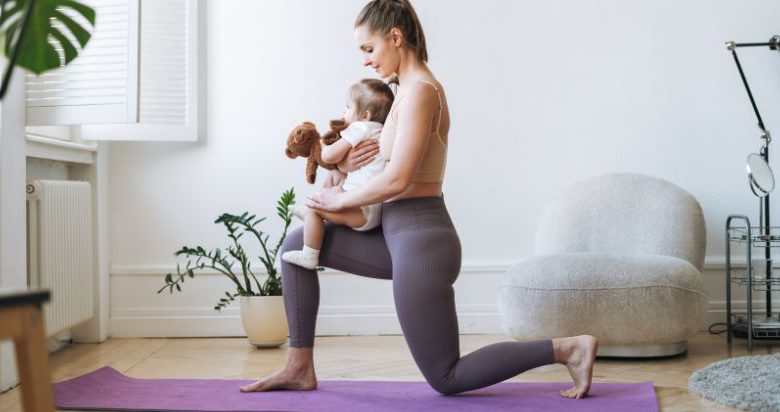Postpartum Exercise: A New Mom’s Guide to Fitness

Postpartum Exercise: A New Mom’s Guide to Fitness
Welcome to the wonderful and often chaotic journey of motherhood! As a new mom, your world has transformed, and amidst the joy of welcoming your little one, you may be wondering how to ease back into fitness. This guide will help you navigate postpartum exercise with realistic expectations, a focus on self-care, and, most importantly, a bit of fun! (If you are a still-expecting mom, don’t miss our Eight Things Moms Should Do When Learning They’re Expecting.)
First and foremost, remember that every body is different. Give yourself grace as you embark on this journey. It’s essential to prioritize your health and well-being, which includes finding joy in movement. Exercise doesn’t have to be a chore—it can be a fulfilling way to connect with your body and your baby.
“When Can I Start Exercising Postpartum?”
Before diving back into your fitness routine, it’s crucial to consult with a doctor familiar with your medical history. However, there are general guidelines most healthcare providers follow:
- Kegels, walking, and light stretching can usually be done right away, provided you feel comfortable and are pain-free.
- For Vaginal Births: If you experienced no major complications, you can typically resume running, strength training, and other high-impact workouts after 6-8 weeks.
- For C-Sections: Recovery usually requires more time. You’ll need at least 8 weeks before beginning high-impact workouts. Collaborate closely with your healthcare provider for personalized guidance.
Above all, listen to your body. If you experience pain or discomfort during any postnatal workout, it’s a sign to slow down. A good rule of thumb is: you should be able to hold a conversation during workouts. If you can sing, though, you might be under doing it!
Exercises for the First 6-8 Weeks
Here are some gentle exercises to get you started during the early weeks of recovery, in accordance with exercises recommended by Mayo Clinic for postpartum fitness:
- Pelvic Floor Exercises (Kegels): Strengthen the muscles that support your uterus, bladder, and bowels.
- Sit or lie comfortably, contract your pelvic floor muscles (as if stopping urination), hold for 3-5 seconds, and release. Repeat 10 times, aiming for 3 sessions per day.
- Diaphragmatic Breathing: Helps strengthen your core and promotes relaxation.
- Lie on your back with knees bent. Inhale deeply, letting your belly rise, then exhale, letting it fall. Do this for 5-10 minutes daily.
- Glute Bridges: Strengthens glutes and core muscles.
- Lie on your back with knees bent, lift your hips to form a straight line from shoulders to knees. Squeeze your glutes at the top, hold for 2-3 seconds, and lower. Repeat 10-15 times for 2-3 sets.
- Clam Shells: Strengthens hips and pelvic floor.
- Lie on your side with knees bent. Keeping your feet together, lift your top knee without moving your pelvis. Lower and repeat 10-15 times on each side for 2-3 sets.
- Cat-Cow Stretch: Increases spine flexibility and alleviates back pain.
- Start on all fours, inhale and arch your back (cow), then exhale and round your back (cat). Repeat 10-15 times.
- Walking: A gentle way to ease back into cardio.
- Start with short walks and gradually increase duration and intensity.
- Wall Sits: Strengthens legs and core.
- Stand against a wall, slide down into a squat, and hold for 20-30 seconds, engaging your core.
Finding Time for Exercise with a Newborn
Juggling a new baby and creating a postpartum workout plan can seem impossible, but with some planning, you can make it happen. Here are some tips:
- Start Small: Focus on pelvic floor exercises and gentle stretches that can be done while sitting or lying down.
- Naptime Workouts: Take advantage of baby’s naps for quick 5-10 minute sessions. Simple movements like bodyweight squats or glute bridges can be effective in short bursts.
- Include Your Baby: Strap your baby into a carrier for gentle walks or do standing exercises like lunges. Tummy time for your baby can double as time for you to do glute bridges or modified push-ups.
- Schedule Short Workouts: Break your exercise into manageable chunks. Aim for 5-10 minutes three times a day—small but consistent efforts add up over time.
- Partner Up: Ask your partner or a family member to watch the baby for 10-15 minutes, giving you time for a quick workout. You can even take turns exercising with your partner.
- For more tips on managing a routine, especially as a mom that balances work and family life, visit our page here!
“Will Exercise Affect My Milk Supply?”
Maintaining milk supply is a common concern for mothers eager to start or get back into a fitness routine, but good news! According to Micky Marie Morrison, a licensed physical therapist and perinatal fitness educator, exercise is generally safe and won’t negatively affect your milk supply. That said, if you’re engaging in intense exercise after the recommended 6-8 weeks of recovery, you’ll want to consider the timing of feedings to manage lactic acid build-up. After intense workouts, lactic acid levels in breast milk can increase, producing a sour taste for up to 90 minutes.
However, the moderate, more recovery-centered exercise recommended during the first 6-8 weeks postpartum doesn’t lead to higher lactic acid levels, so your baby is unlikely to notice any changes. If you’d like to add more intense workouts to your routine in the future, try nursing before your workout to avoid any potential taste changes in your breast milk.
Benefits of Postpartum Exercise
- Physical Recovery: Postpartum exercise helps with recovery by strengthening core muscles, improving posture, and boosting energy levels. Regular movement helps you feel more like yourself and builds a foundation for future strength.
- Weight Management: While weight loss shouldn’t be your primary focus right away, gentle exercise can help rev up your metabolism and prevent excessive weight gain, reducing the risk of health issues like postpartum diabetes or cardiovascular disease.
- Mental Health: Exercise has been shown to reduce stress, anxiety, and symptoms of postpartum depression. It can also improve sleep quality—something all new moms can appreciate! Even a short walk can lift your spirits and help you feel more energized.
- Improved Mobility and Flexibility: Postpartum exercise improves strength, flexibility, and range of motion. This makes it easier to care for your little one and can reduce post-birth discomfort.
Building a Long-Term Fitness Routine
Once you’ve successfully navigated the first 6-8 weeks, you may be ready to add more variety and intensity to your workouts. Some exercises you can gradually incorporate into your postpartum routine include:
- Low-Impact Cardio: Swimming, cycling, or low-impact aerobics can help build endurance without putting too much strain on healing tissues.
- Strength Training: Focus on bodyweight exercises first, like squats, lunges, and push-ups, before gradually adding weights.
- Yoga or Pilates: These activities focus on core strength, balance, and flexibility, making them perfect for rebuilding a strong foundation.
- Postpartum Fitness Classes: Many communities offer mommy-and-me fitness classes, where you can bond with your baby while working out with other new moms. These classes often focus on gentle, full-body movements that are safe for postpartum recovery.
Final Thoughts: Embrace the Journey
Postpartum exercise is not about rushing to “bounce back” but about nurturing your physical and mental well-being. As a new mom, it’s easy to feel pressure to return to your pre-baby body, but it’s more important to prioritize your health and happiness. Set realistic goals, listen to your body, and find ways to make exercise enjoyable. You’re not just building physical strength—you’re boosting your energy and mental health, laying a foundation for lifelong well-being.
Embrace this new chapter with patience and grace. You’ve already accomplished something incredible, and you deserve to feel strong and empowered in your postpartum journey.
References:
Mayo Clinic Staff. (2022, October 8). Exercise after pregnancy: How to get started. Mayo Clinic. https://www.mayoclinic.org/healthy-lifestyle/labor-and-delivery/in-depth/exercise-after-pregnancy/art-20044596
The Bump. (2022, March 24). 4 big things you need to know about exercising while breastfeeding. The Bump. https://www.thebump.com/a/4-big-things-you-need-to-know-about-exercising-while-breastfeeding





